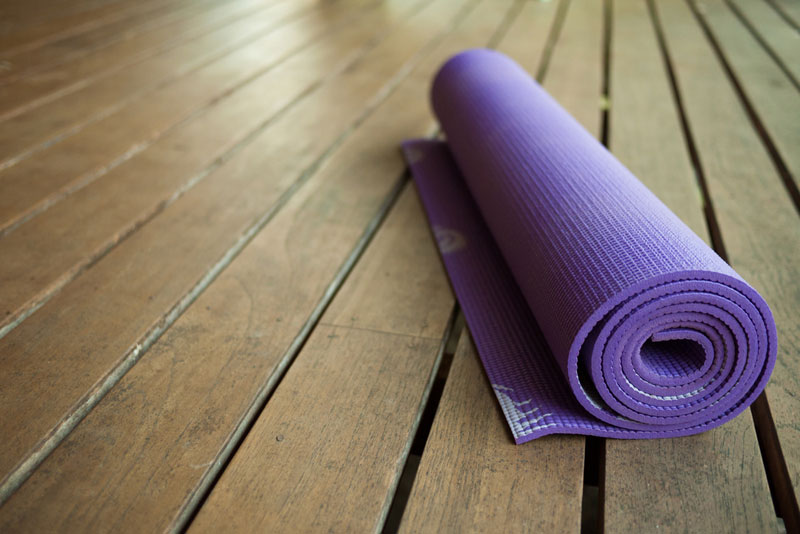Why Copying Yoga Poses from Magazines Could Be a Bad Move

Handstand scorpion, anyone? Yoga poses depicted in magazines and other media outlets may draw eyeballs, but most people probably shouldn't try them, a new study suggests.
Images of yoga in the media often show poses that are unsafe, or just aren't doable for the average person, the researchers said. This means that people could get hurt if they attempt the poses. And for people who've never tried yoga, seeing the images might turn them off from starting yoga altogether, the researchers said.
"It kind of scares people off from starting a practice," said study researcher Nadezhda Vladagina, a graduate student at Pacific University School of Professional Psychology in Hillsboro, Oregon. "They might feel that they're not flexible enough and [yoga] isn't something their body is capable of doing," Vladagina said. "Meanwhile, already existing practitioners [of yoga] see these images of what yoga's supposed to look like, and they force themselves into these postures, essentially often causing injury."
Practicing yoga has been linked with a number of health benefits, including reduced stress, anxiety, depression and chronic pain, as well as improved sleep. However, yoga can lead to injuries if people don't practice it properly. Many yoga injuries happen when people push themselves beyond their capabilities; for example, by overstretching, or by putting their joints under too much tension, the researchers said. Such unhealthy poses may be reinforced by images of yoga in the media, they said.
In the study, Vladagina and her colleagues evaluated more than 1,500 images of yoga postures published in 33 issues of a popular yoga magazine between 2007 and 2014.
They found that about 45 percent of the images showed poses that were determined to be unsafe because they were presented in a way that could lead to injury. For example, some images showed misalignment of the shoulders or the neck.
What's more, 50 percent of images showed people attempting to do moderate or advanced versions of a pose, and about 22 percent showed people in extremely difficult versions of a pose.
Get the world’s most fascinating discoveries delivered straight to your inbox.
About one-quarter of images showed beginner-level poses, but still, 20 percent of these images showed the poses being done in a way that could lead beginners to hurt themselves, the researchers said.
"The more people are looking through these magazines, the more often they see these poses that there's no realistic way they're going to get into them, and if they do there's a high chance of causing injury to themselves," Vladagina told Live Science. [3 Ways to Keep Yoga Risk Free]
Stereotypical images
Study researcher Elika Razmjou, also a graduate student at Pacific University, said that people can be harmed when they compare themselves to images they see in the media, and create an expectation of what they're supposed to look like, instead of listening to their own body.
"I think those expectations are what can kind of push people sometimes to push beyond what their body is willing and able to do…and that can present a risk of injury," Razmjou said.
Another aspect of the study looked at the demographics of people shown in the yoga poses in the magazine. They found that of 3,100 images analyzed, 71 percent of people in the images were young, 46 percent were thin, 72 percent were white and 74 percent were female.
These limited demographics may discourage people from starting a yoga practice, because they may think they don't fit the image of yoga practitioners portrayed in the media, the researchers said.
"If we're only showing able-bodied, white, skinny, already-fit women, those are the only people who think yoga is applicable to them, and that's not the case at all," said study researcher Heather Freeman, also a graduate student at Pacific University.
Holistic view of yoga?
Finally, the researchers looked at the articles in the magazine, to see how often the articles mentioned the foundational principles of yoga (called the eight limbs of yoga). These principles go beyond the physical practice of postures and breathing exercises, and include ethical practices (such as the practice of nonviolence), self-care practices and meditation.
The researchers found that introspective practices, such as meditation, were mentioned explicitly in only about 8 percent of the articles, and ethical practices were mentioned in 5 percent of the articles. In contrast, yoga postures were explicitly mention in 47 percent of the articles, and breathing exercises were mentioned in 25 percent.
"When we just rely on [the physical] aspect to get people involved in yoga…that’s such a limited door, when we could be opening up so many other doors," for people who may not be able to do the physical aspects of yoga, Freeman said.
The researchers said they would like to see more holistic representations of yoga in the media, as well as more diversity in the people depicted practicing yoga.
Above all, yoga should be seen as a personal practice that helps people have a better relationship with themselves, they said. "Yoga should really be an individualized practice as opposed to a broadband thing that’s applied to everyone the same way," Vladagina said.
Original article on Live Science.

Rachael is a Live Science contributor, and was a former channel editor and senior writer for Live Science between 2010 and 2022. She has a master's degree in journalism from New York University's Science, Health and Environmental Reporting Program. She also holds a B.S. in molecular biology and an M.S. in biology from the University of California, San Diego. Her work has appeared in Scienceline, The Washington Post and Scientific American.

